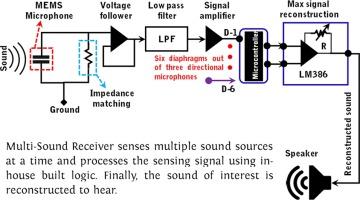利用苍蝇 Ormia ochracea 耳朵启发的 MEMS 定向麦克风阵列设计多声接收器并确定其特性
IF 3.4
2区 物理与天体物理
Q1 ACOUSTICS
引用次数: 0
摘要
由苍蝇赭耳启发的微机电定向麦克风在缩小尺寸的同时显示出方向性。这一领域的进展仅限于原型开发和可行性研究,因此在实际应用中的选择有限。在这里,我们介绍了这一方向性麦克风趋势如何对多个传入声源做出反应,以及转换感应声音后我们能听到什么。我们开发了一种多声源接收器,它能接收多种传入声音,并加入模拟逻辑来区分它们。在强度、频率和传播角度未知的情况下,在消声室中使用大量声源对所开发的设备进行评估。研究结果很有希望,这使得在各种声学应用中使用蝇类赭石耳朵启发的 MEMS 定向麦克风取得了进展。本文章由计算机程序翻译,如有差异,请以英文原文为准。

Design and characterizations of a multi–sound receiver using fly Ormia ochracea's ears–inspired MEMS directional microphone array
Fly Ormia ochracea ears–inspired MEMS directional microphones show directionality at a reduced size. The progress within this area is limited to prototype development and feasibility studies, which leaves a limited choice of using it in practical applications. Here, we presented how this trend of directional microphones reacts to multiple incoming sound sources and what we can hear after converting the sensing sound. A multi-sound receiver is developed that receives multiple incoming sounds, and an analog logic is added to differentiate them. When the intensity, frequency, and propagation angle are unknown, the developed device is evaluated in an anechoic chamber using numerous sound sources. The results are promising and enable the advances of using fly Ormia ochracea's ears-inspired MEMS directional microphone in various acoustic applications.
求助全文
通过发布文献求助,成功后即可免费获取论文全文。
去求助
来源期刊

Applied Acoustics
物理-声学
CiteScore
7.40
自引率
11.80%
发文量
618
审稿时长
7.5 months
期刊介绍:
Since its launch in 1968, Applied Acoustics has been publishing high quality research papers providing state-of-the-art coverage of research findings for engineers and scientists involved in applications of acoustics in the widest sense.
Applied Acoustics looks not only at recent developments in the understanding of acoustics but also at ways of exploiting that understanding. The Journal aims to encourage the exchange of practical experience through publication and in so doing creates a fund of technological information that can be used for solving related problems. The presentation of information in graphical or tabular form is especially encouraged. If a report of a mathematical development is a necessary part of a paper it is important to ensure that it is there only as an integral part of a practical solution to a problem and is supported by data. Applied Acoustics encourages the exchange of practical experience in the following ways: • Complete Papers • Short Technical Notes • Review Articles; and thereby provides a wealth of technological information that can be used to solve related problems.
Manuscripts that address all fields of applications of acoustics ranging from medicine and NDT to the environment and buildings are welcome.
 求助内容:
求助内容: 应助结果提醒方式:
应助结果提醒方式:


